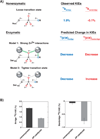Kinetic isotope effects for alkaline phosphatase reactions: implications for the role of active-site metal ions in catalysis
- PMID: 17630738
- PMCID: PMC3171187
- DOI: 10.1021/ja072196+
Kinetic isotope effects for alkaline phosphatase reactions: implications for the role of active-site metal ions in catalysis
Abstract
Enzyme-catalyzed phosphoryl transfer reactions have frequently been suggested to proceed through transition states that are altered from their solution counterparts, with the alterations presumably arising from interactions with active-site functional groups. In particular, the phosphate monoester hydrolysis reaction catalyzed by Escherichia coli alkaline phosphatase (AP) has been the subject of intensive scrutiny. Recent linear free energy relationship (LFER) studies suggest that AP catalyzes phosphate monoester hydrolysis through a loose transition state, similar to that in solution. To gain further insight into the nature of the transition state and active-site interactions, we have determined kinetic isotope effects (KIEs) for AP-catalyzed hydrolysis reactions with several phosphate monoester substrates. The LFER and KIE data together provide a consistent picture for the nature of the transition state for AP-catalyzed phosphate monoester hydrolysis and support previous models suggesting that the enzymatic transition state is similar to that in solution. Moreover, the KIE data provides unique information regarding specific interactions between the transition state and the active-site Zn2+ ions. These results provide strong support for a model in which electrostatic interactions between the bimetallo Zn2+ site and a nonbridging phosphate ester oxygen atom make a significant contribution to the large rate enhancement observed for AP-catalyzed phosphate monoester hydrolysis.
Figures






Similar articles
-
Probing the origin of the compromised catalysis of E. coli alkaline phosphatase in its promiscuous sulfatase reaction.J Am Chem Soc. 2007 May 2;129(17):5760-5. doi: 10.1021/ja069111+. Epub 2007 Apr 6. J Am Chem Soc. 2007. PMID: 17411045 Free PMC article.
-
Alkaline phosphatase mono- and diesterase reactions: comparative transition state analysis.J Am Chem Soc. 2006 Feb 1;128(4):1293-303. doi: 10.1021/ja056528r. J Am Chem Soc. 2006. PMID: 16433548 Free PMC article.
-
Functional interrelationships in the alkaline phosphatase superfamily: phosphodiesterase activity of Escherichia coli alkaline phosphatase.Biochemistry. 2001 May 15;40(19):5691-9. doi: 10.1021/bi0028892. Biochemistry. 2001. PMID: 11341834
-
Structure and mechanism of alkaline phosphatase.Annu Rev Biophys Biomol Struct. 1992;21:441-83. doi: 10.1146/annurev.bb.21.060192.002301. Annu Rev Biophys Biomol Struct. 1992. PMID: 1525473 Review.
-
The mechanism of the alkaline phosphatase reaction: insights from NMR, crystallography and site-specific mutagenesis.FEBS Lett. 1999 Nov 26;462(1-2):7-11. doi: 10.1016/s0014-5793(99)01448-9. FEBS Lett. 1999. PMID: 10580082 Review.
Cited by
-
Experimental analyses of the chemical dynamics of ribozyme catalysis.Curr Opin Chem Biol. 2008 Dec;12(6):626-39. doi: 10.1016/j.cbpa.2008.10.005. Epub 2008 Oct 24. Curr Opin Chem Biol. 2008. PMID: 18952193 Free PMC article. Review.
-
Promiscuity in the Enzymatic Catalysis of Phosphate and Sulfate Transfer.Biochemistry. 2016 Jun 7;55(22):3061-81. doi: 10.1021/acs.biochem.6b00297. Epub 2016 May 26. Biochemistry. 2016. PMID: 27187273 Free PMC article. Review.
-
Analysis of Phosphoryl-Transfer Enzymes with QM/MM Free Energy Simulations.Methods Enzymol. 2018;607:53-90. doi: 10.1016/bs.mie.2018.05.005. Epub 2018 Aug 14. Methods Enzymol. 2018. PMID: 30149869 Free PMC article.
-
Mechanistic Studies of Homo- and Heterodinuclear Zinc Phosphoesterase Mimics: What Has Been Learned?Front Chem. 2019 Feb 21;7:82. doi: 10.3389/fchem.2019.00082. eCollection 2019. Front Chem. 2019. PMID: 30847339 Free PMC article. Review.
-
Substrate-promoted formation of a catalytically competent binuclear center and regulation of reactivity in a glycerophosphodiesterase from Enterobacter aerogenes.J Am Chem Soc. 2008 Oct 29;130(43):14129-38. doi: 10.1021/ja803346w. Epub 2008 Oct 3. J Am Chem Soc. 2008. PMID: 18831553 Free PMC article.
References
Publication types
MeSH terms
Substances
Grants and funding
LinkOut - more resources
Full Text Sources

